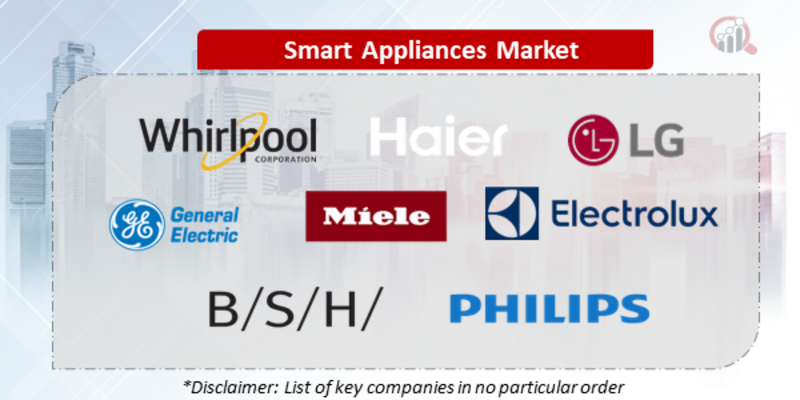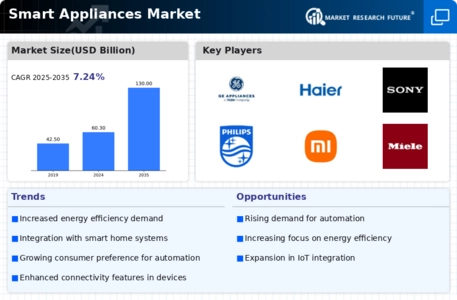Top Industry Leaders in the Smart Appliances Market

The Competitive Landscape of the Smart Appliances Market
Across sleek countertops and connected kitchens, the future of domesticity unfolds – a symphony of connected appliances whispering convenience and efficiency. This dynamic Smart Appliances market pulsates with the competitive energy of players vying for control over these tireless conductors of culinary choreography and household management. Unveiling the strategies, crucial factors, and overall landscape of this intricate market is vital for navigating its currents and securing a winning recipe for success.
Some of the Smart Appliances companies listed below:
- Whirlpool Corp.
- Haier Co. Ltd.
- LG Inc.
- General Electric Co.
- Miele & Cie. KG
- Electrolux AB
- BSH Hausgerate GmbH
- Philips N.V.
- Groupe SEB
- Samsung
- Panasonic Corp. among others
Strategies Adopted by Leaders:
- Technological Prowess: LG Electronics and Samsung lead the charge with advanced smart refrigerators boasting food management systems, connected ovens offering remote control and personalized cooking, and laundry appliances with AI-powered stain removal and cycle optimization, catering to demanding needs across diverse households.
- Vertical Specialization: Whirlpool and Miele focus on specific segments like kitchen appliances or smart vacuum cleaners, achieving unmatched expertise and cost-effectiveness within their chosen domains.
- Ecosystem Play and Platform Integration: Bosch Home and Apple offer comprehensive platforms with smart appliances seamlessly connecting to smartphones, voice assistants, and smart home systems, building brand loyalty and strengthening user experience.
- Focus on Design and Aesthetics: Companies like Electrolux and KitchenAid understand the importance of blending smart functionalities with stylish designs, offering modern aesthetics that complement home decor.
- Partnerships and Collaborations: Open standards and interoperability are key, with players like Zigbee Alliance and Home Connectivity Alliance forging collaborations to ensure device compatibility and expand market reach.
Critical Factors for Market Share Analysis:
- Functionality and Value Proposition: Companies offering smart appliances with compelling features like remote control, automation capabilities, and energy efficiency command premium prices and secure market share by demonstrably simplifying daily routines and managing housework.
- Ease of Use and User Interface: Ensuring intuitive setup, user-friendly controls, and seamless integration with existing ecosystems is crucial for user adoption and brand loyalty.
- Security and Data Privacy: Providing robust security protocols, data encryption, and transparent privacy policies is paramount in a market increasingly concerned about connected devices and sensitive data.
- Interoperability and Connectivity: Devices compatible with diverse platforms and operating systems expand market reach and cater to users with existing smart home investments.
- Cost Competitiveness and Affordability: Balancing advanced features with an attractive price point is crucial for capturing market share, particularly in price-sensitive segments like small appliances and countertop gadgets.
New and Emerging Companies:
- Startups like June Intelligent Oven and Brava Smart Oven: These innovators focus on developing niche smart appliances with specific functionalities like baking or air frying, challenging established players in targeted segments with innovative features and user-centric design.
- Academia and Research Labs: MIT's Media Lab and Carnegie Mellon University's Human-Computer Interaction Institute explore disruptive technologies like AI-powered recipe generation, connected food preparation robots, and personalized dietary coaching appliances, shaping the future of culinary experiences.
- Material Science Companies: Corning and Schott develop advanced materials with enhanced heat resistance, scratch-resistant surfaces, and improved energy efficiency, enabling the development of durable and sustainable smart appliances.
Latest Company Updates:
Aug. 29, 2023, Samsung Electronics, LG Electronics, and Vestel announced their partnership to enable users to control third-party smart appliances through their preferred apps. Cross-brand smart appliance control initiative marks the industry's effort based on the HCA's Interface Specification 1.0, facilitating Cloud-to-Cloud (C2C) interoperability for certain home appliances and HVAC systems. The collaboration enables a framework for C2C cross-control, offering users meaningful benefits.
May 30, 2023, Hindware Smart Appliances launched a modern, high-performing Fumi Ceiling Fan that combines a sturdy, evergreen design with energy efficiency. Equipped with an efficient BLDC motor, the new smart fan consumes 34 watts of energy, resulting in 60% less power consumption than ordinary fans. Moreover, the ceiling fan offers a long run time on the inverter with zero humming sound, even at 360 RPM.
May 03, 2023, upliance.ai, a startup offering smart and connected home appliances, announced integrating AI chatbot, ChatGPT in its flagship product. With ChatGPT integration, consumers get speech recognition, assistance to customize their searches, and get AI-assisted recipes. The smart appliance brand recently launched a smart cooking assistant, DelishUp. The product simplifies cooking with simple instructions and its smart c jar that automates the processes from chopping to stirring.
Mar.16, 2023, Hindware Home Innovation Limited announced the inauguration of its exclusive brand store, the Hindware Smart Appliances Universe, strengthening its offline presence. Strategically located, the brand store showcases the extensive range of Hindware Smart Appliances. The Hindware Smart Appliances Universe is India's biggest offline retail store. It is designed to offer consumers a retail experience and an opportunity to explore the wide product portfolio.








